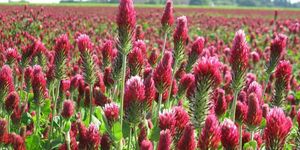Lack of Cover Crop Seed Adds Stress to Farmers’ Season
 Whether you’re a farmer intent on using cover crops for weed suppression on prevented plant acres or a grower wanting more traditional benefits—to prevent erosion, improve water-holding capacity and reduce fertilizer use—your No. 1 challenge this season is likely the same: seed availability.
Whether you’re a farmer intent on using cover crops for weed suppression on prevented plant acres or a grower wanting more traditional benefits—to prevent erosion, improve water-holding capacity and reduce fertilizer use—your No. 1 challenge this season is likely the same: seed availability.
Wohltman notes that many of the commonly used small grain cover crops such as rye, wheat, barley and oats are nearly sold out across the seed industry as are many annual forage grasses, such as forage ryegrasses, and warm-season grasses such as forage sorghums and sorghum sudangrass.
“Outside of waiting for better availability of a small grain crop or seeding a traditional non-grain cover crop, like clovers and brassicas, farmers across the country are currently extremely limited in their choices,” he says.
A Farm Journal Pulse survey U.S. farmers conducted last week indicates 41% plan to plant a cover crop. Nationwide, more farmers are planting cover crops, with national cover crop acreage increasing by 50% over the past five years, according to the 2017 Census of Agriculture. This season, the lack of conventional cover crop seed choices could alter what farmers plant and when.
Richard Flournoy, deputy administrator of product management for the USDA-Risk Management Agency (RMA), notes that the agency has a “broad definition” for cover crops used for crop insurance purposes.
“It’s generally many things, that any crop that can be planted for erosion control, soil improvement, or any other type of conservation practice,” he told AgriTalk host Chip Flory and in a story posted to AgWeb: USDA Confirms Silage Corn Can Be Planted On Prevent Plant Acres
Additionally, Flournoy says an “ag expert” can deem a crop eligible by determining the prospective crop meets all the cover crop definitions.
That means even soybean or corn can be considered a cover crop. Bear in mind that you can’t harvest the crops for grain.
As you evaluate cover crops for this season, Anna Morrow says to identify your priorities for growing one. One of the big ones for farmers this year is weed suppression on prevented plant acres.
“If you have heavy weed pressure with some really difficult weeds, such as waterhemp, Palmer amaranth and marestail, it may benefit you to go ahead and plant a grass cover crop, and then you can control those weeds throughout the summer with a broadleaf herbicide,” says Morrow, program manager for the Midwest Cover Crops Council (MCCC). You can review possible cover crop options at the MCCC website at https://bit.ly/2Wn7f6j.
Wohltman cautions that for farmers wanting to plant a cover crop in the next week or two, there still won’t be many traditional options for purchase.
“For farmers willing to wait until July or even August when a new round of cover crop seed is available, things will be a little bit better,” he says. “New crop oats will be ready in mid- to late July, but new-crop rye will not be ready until mid-August at the earliest.”
A meeting in Ada, Ohio, tonight will address cover crop seed and production for farmers in the state. Find out more here: https://bit.ly/2J5W0L4.
Morrow adds that if summer annual seed availability is low, you might consider controlling weeds until August with herbicides and then plant a cool season species or mix.
Even with new cover crops coming from the field, Wohltman says to expect supplies to be tight.
“Talk with your trusted adviser as soon as possible, because of the various weather events that are still happening across the country,” he says. “The earlier you can turn in your order, the earlier you’re going to get your name in the que.”
As for price, Wohltman says you can expect to pay between $18 and $25 acre for seed, depending on which cover crop you choose.
Other factors to consider in the process of selecting a cover crop for this season, include:
Evaluate your herbicide program. Consider the potential impact of any herbicide you already applied this spring in anticipation of a cash crop. Refer to herbicide labels for details on potential carryover. Brassica and legume cover crops can be especially sensitive to residual herbicides.
Plant clean seed. Make sure that your seed is clean so you don’t introduce any new weed species to the field. Check the seed tag so you know the germination rate and that it gives you a germination rate, which can influence planting populations.
“If you’ve got good, clean seed that has a bit of a lower germination rate, there’s nothing necessarily wrong with that seed but you’ll want to plant it at a higher seeding rate,” Morrow says. “This is especially true if you’re using bin-run seed. At the very least do your own germ tests before planting, if time is of the essence and you can’t send a sample off to be tested.”
Determine your management plan. If you plant a cover now you could get a considerable amount of tillering prior to winter, and you might want to remove some of that top growth before cold weather sets in. “Think about how much growth you’re comfortable with prior to winter, because if that crop gets away from you it could be a bigger issue to manage next spring,” Wohltman says.
Source: Rhonda Brooks, Ag Professional
